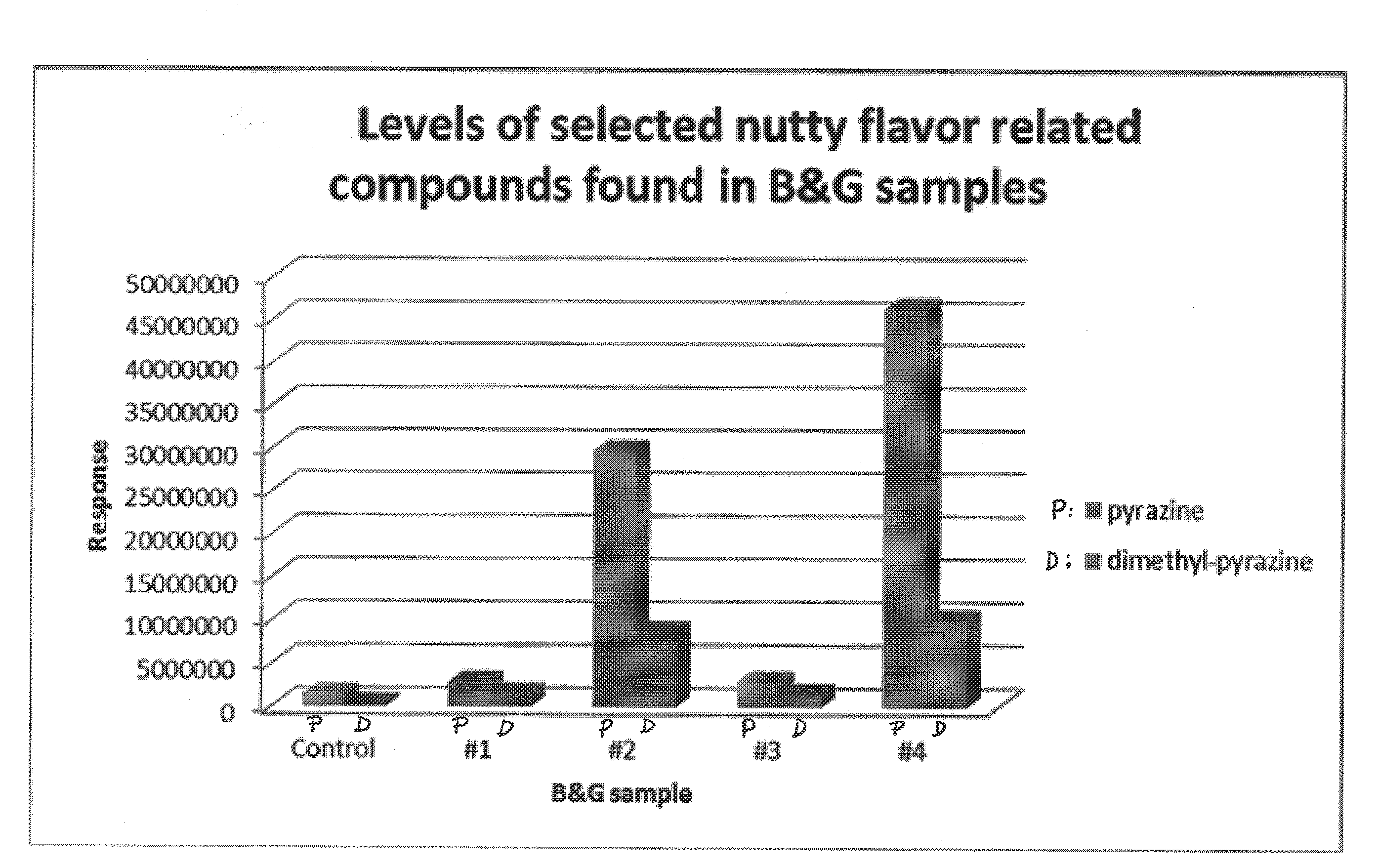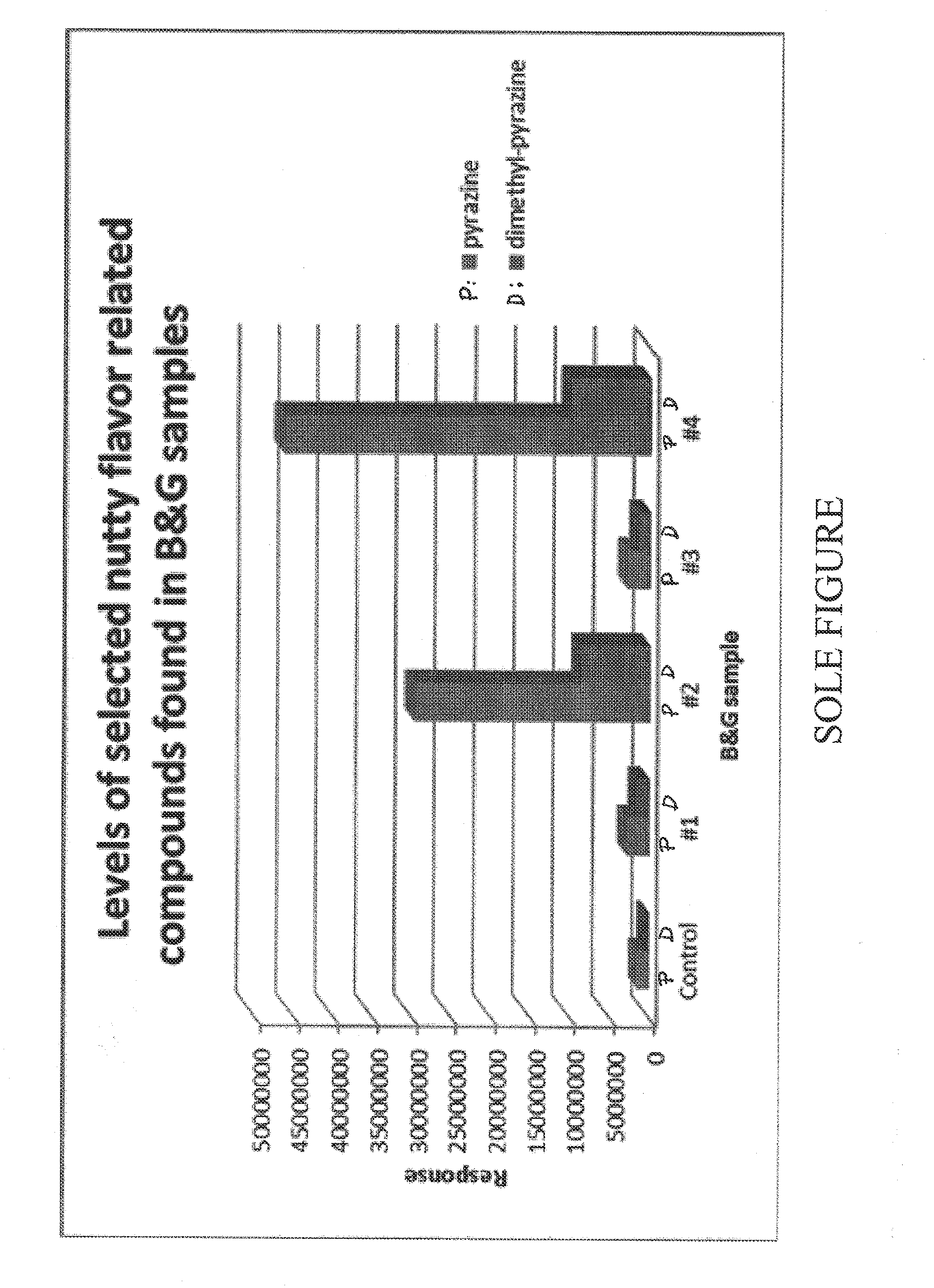Bran And Germ Flavor And Texture Improvement
a bran and germ technology, applied in the field of bran and germ flavor and texture improvement, can solve the problem of still close moisture content of whole grain flour, achieve the effects of improving flavor and texture of bran and germ components, reducing lipase activity, and stabilizing against rancidity
- Summary
- Abstract
- Description
- Claims
- Application Information
AI Technical Summary
Benefits of technology
Problems solved by technology
Method used
Image
Examples
example 1
Part A. Production of Low Pressure Heat Treated Bran and Germ Component with Venting Process
[0097]In this Example, a ground bran and germ component or fraction is hydrated to various amounts and heat treated at various temperatures in a low pressure convey8ing and mixing device with venting, and the moisture content after heat treatment and venting is determined. The treated bran and germ components or fractions are combined with an endosperm fraction to obtain whole grain flours and the moisture contents and lipase activities are determined and compared to those of a control.
[0098]The ground bran and germ component or fraction having an initial moisture content of about 8.29% by weight, is hydrated to about 16.29% by weight and about 26.29% by weight moisture content in a Hobart Mixer (A-200 T, Troy, Ohio) by spraying water into the mixer during mixing at low speed. After completing the water addition, mixing is continued for about 5 minutes.
[0099]An Acrison volumetric feeder with ...
example 2
Baking Function of Whole Grain Flour with Bepex Heat Moisture and Venting Treatment
[0184]In this Example, the baking function of whole grain flour made with low pressure heat treatment using a Bepex Turbulizer® heat treated bran and germ component or fraction produced with venting as in Example 1 was compared to the baking function of untreated whole grain flour. The whole grain flours made with natural proportions of bran and germ and endosperm are listed in Table 2 of Example 1. The cookie test baking method used to evaluate the baking functionality of the whole grain flours was the AACC 10-53 Cookie Baking Test.
[0185]Solvent Retention Capacity (SRC) serves as a practical test to monitor the function of specific flour components, such as the amount of damaged starch. The SRC assay method used was adapted and modified from AACC method 56-10, according to the following procedure:
Materials:
[0186]50 ml centrifuge tubes+caps[0187]5% weight sodium carbonate solvent[0188]Centrifuge (IEC,...
example 3
Sensory Evaluation and Flavor Analysis of 100% Whole Grain Cookies Made with Bepex Turbulizer® Low Pressure, Vented Heat Treated Bran and Germ Components or Fractions
[0233]In this Example, the objectives are to: 1):evaluate the taste of the 100% whole grain cookies (Part 1) made with Bepex Turbulizer® low pressure, vented heat treated bran and germ components or fractions, as made in Examples 1 and 2, and 2) analyze the wheaty flavor of Bepex Turbulizer® low pressure, vented heat treated bran and germ components or fractions as made in Example 1 (Part 2).
Part I Sensory Descriptive Analysis of 100% Whole Grain Cookie
[0234]Whole grain products generally have a wheaty, or green, fatty, oxidized grassy flavor notes, and a grainy taste and are generally less preferred by consumers compared to products made with white flour. Sensory evaluation is used to measure the flavour and texture differences obtained with the low pressure, vented heat treatment process of ground bran and germ compon...
PUM
 Login to View More
Login to View More Abstract
Description
Claims
Application Information
 Login to View More
Login to View More - R&D
- Intellectual Property
- Life Sciences
- Materials
- Tech Scout
- Unparalleled Data Quality
- Higher Quality Content
- 60% Fewer Hallucinations
Browse by: Latest US Patents, China's latest patents, Technical Efficacy Thesaurus, Application Domain, Technology Topic, Popular Technical Reports.
© 2025 PatSnap. All rights reserved.Legal|Privacy policy|Modern Slavery Act Transparency Statement|Sitemap|About US| Contact US: help@patsnap.com



